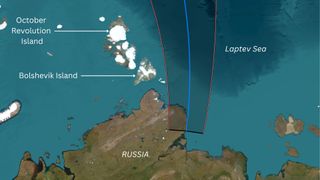Keep up with all things eclipse!
Check out our solar eclipse live blog to keep up with the latest eclipse news and features.
On Aug. 12, 2026, Europe will experience its first total solar eclipse in 27 years.
At the point of greatest eclipse, totality will last 2 minutes, 18 seconds — a relatively short time compared with the total solar eclipses in 2024 and 2027. For this solar eclipse, totality will be visible from remote parts of Russia, eastern Greenland, western Iceland and the Iberian Peninsula. Here’s where to witness the August 2026 total solar eclipse from Russia, Greenland, Iceland, Spain, Portugal and the Mediterranean Sea.
Remember that it’s unsafe to look directly at the sun during the partial phases of an eclipse. At all times except when the sun is completely blocked by the moon, you must wear solar eclipse glasses. Read our guide on how to observe the sun safely.
Entire path of totality
This total solar eclipse will have a long and broad path, rising in remote Siberia and setting just east of the Balearic Islands in the Mediterranean Sea. That journey is 5,133 miles (8,260 kilometers), during which the moon’s central umbral shadow will be 182 miles (293 km) wide and take 96 minutes to flash across the planet.
Only a small portion of that path crosses land, with 15.2 million people — the vast majority in northern Spain — destined to witness totality that day, according to Time and Date.
Related: 16 best places to see the 2026 total solar eclipse
Path of totality in Russia

The rise of this eclipse from a very remote part of the northern Siberian coast will be lonely. A totally eclipsed sun will be visible just above the northern horizon at 3:37 a.m. ANAT, as seen from Siberia’s Taymyr Peninsula. Here, beside the Laptev Sea, the sun never sets during August, making the maximum 85 seconds of totality the darkest of the entire 24 hours. Few, if any, humans will witness it. As the path of totality heads across the Vilkitsky Strait into the Arctic Ocean, it will pass Severnaya Zemlya, an archipelago of usually ice-packed Arctic islands.
Related: Eclipse 2026: The next total solar eclipse will be Europe’s 1st in 27 years
Path of totality in Greenland

After rising in an uninhabited place, the path of totality will cross one of the least-populated nations on Earth. Just 56,000 people live in Greenland, and few, if any, live under the path of this eclipse, which curves through the east of this vast island, passing only the remote settlements of Mestersvig and Nyhavn in East Greenland.
Just before the moon’s shadow exits in southeastern Greenland, it will pass across almost all of Scoresby Sound, which will experience 1 minute, 45 seconds of totality, and depart at the Blosseville Coast. Expect multiple cruise ships to be in this region, where eclipse chasers on a once-in-a-lifetime Arctic trip will vie for views of totality among icebergs. From Scoresby and the Blosseville Coast, the totally eclipsed sun will hang about 26 degrees above the western horizon.
Cruise itineraries that stay for a few nights will have a decent chance of seeing the northern lights after midnight, though the hours of darkness in August will be minimal.
Path of totality in Iceland

The “Land of Fire and Ice” will be an irresistible destination for eclipse chasers who want to pair totality with a range of other spectacles, including volcanoes, waterfalls, long days and the chance to see the northern lights. Iceland’s unpredictable weather could prove challenging for eclipse watching, but there are reasons to be hopeful. Beautiful days are possible in August, and the eclipse will happen late in the day there at about 25 degrees above the west-southwest horizon. That means you will have all day to choose a location along Iceland’s western coast using Iceland’s very detailed weather forecasts.
Expect crowds at scenic spots along the west coast and cruise ships to depart the capital, Reykjavik, for the point of greatest eclipse, which will be 18 miles (30 km) off the coast. Reykjavik will get 59 seconds of totality; Garður Old Lighthouse on Reykjanes Peninsula will get 1 minute, 42 seconds; Snæfellsjökull on Snæfellsnes Peninsula will get 2 minutes, 5 seconds; and Látrabjarg in Iceland’s Westfjords will get 2 minutes, 14 seconds, (the longest in the nation).
Path of totality in Spain and Portugal

After crossing a few thousand miles of ocean, the eclipsed sun will arrive over Galicia on Spain’s northwestern coast at 7:30 p.m. CEST. Maximum totality will occur between Canero and Luarca at 1 minute, 50 seconds. Over the next 7 minutes, 20 seconds, the moon’s shadow will thread a needle through the country’s north as it narrowly misses Madrid and Barcelona, both of which will see a 99% partial solar eclipse.
The most important factor to consider when you’re researching where to go in Spain is the altitude of the eclipse. Annoyingly, clouds are more likely in the places where the eclipse will be higher in the sky (northwestern Spain), and clear skies are expected where the sun will be low in the sky (eastern Spain).
Just before sunset across the region, the eclipse will be a maximum of 10 degrees above the western horizon (from Galicia), and will sink to just a couple of degrees above the horizon by the time it reaches Spain’s east coast at Valencia and Tarragona. That makes the latter a poor choice because mountains to the west will generally block the view of the eclipse. However, there are exceptions with expansive beaches, such as Parc Natural del Delta de l’Ebre in Tarragona.
A sweet spot may be around Palencia and Burgos in Castile and León, close to the centerline of the path in a region with both flat horizons and a high chance of clear skies. This central region also has dark rural skies, which may allow views of the Milky Way and the peak of the annual Perseid meteor shower on the night of Aug. 12.
Although this is primarily an eclipse for northern Spain, a tiny area of Portugal will fall within the moon’s shadow. Route N308, which runs from Rio de Onor to Guadramil, marks the southern edge of the path. Anywhere beyond that, in Portugal’s extreme northeast, will experience totality for up to 27 seconds.
Path of totality in the Mediterranean Sea

The best climate in the entire path of totality is found in the Mediterranean Sea, where the moon’s shadow will depart the planet east of the Balearic Islands, an archipelago off eastern Spain. Tour groups and tourists will flock to Mallorca, the largest of the Balearic Islands, where the sight of an eclipsed sun — complete with a golden corona — will be the prize just a degree or so above the ocean. Anywhere on the west coast will do, but Sant Elm will have the longest totality (1 minute, 36 seconds). Ibiza and Menorca are also good choices, although totality will be about 20 seconds shorter there.
Additional resources
Want to look further ahead? You can find a concise summary of solar eclipses out to 2030 on NASA’s eclipse website. Read more about solar and lunar eclipses on EclipseWise.com, a website dedicated to predictions of eclipses. See beautiful maps on eclipse cartographer Michael Zeiler’s GreatAmericanEclipse.com and interactive Google Maps on Xavier Jubier’s eclipse website. You can find climate and weather predictions by meteorologist Jay Anderson on eclipsophile.com.
Bibliography
Anderson, J. (May 2024). Eclipsophile: Total Solar Eclipse Aug. 12, 2026. Retrieved Jun. 4, 2024, from https://eclipsophile.com/tse2026/
Bakich, M. and Zeiler, M. (2022). Atlas Of Solar Eclipses 2020-2045. https://www.greatamericaneclipse.com/books/atlas-of-solar-eclipses-2020-to-2045
Espenak, F. Solar Eclipse Prime Page: Total Solar Eclipse of 2026 Aug. 12. Retrieved Jun. 4, 2024, from: https://eclipsewise.com/solar/SEprime/2001-2100/SE2026Aug12Tprime.html
Jubier, X. (n.d.). Solar eclipses: Interactive Google Maps. Retrieved Jun. 4, 2024, from http://xjubier.free.fr/en/site_pages/SolarEclipsesGoogleMaps.html
Time and Date. (n.d.). Aug. 12, 2026 Total Solar Eclipse. Retrieved Jun. 4, 2024 from https://www.timeanddate.com/eclipse/solar/2026-august-12





















Discussion about this post